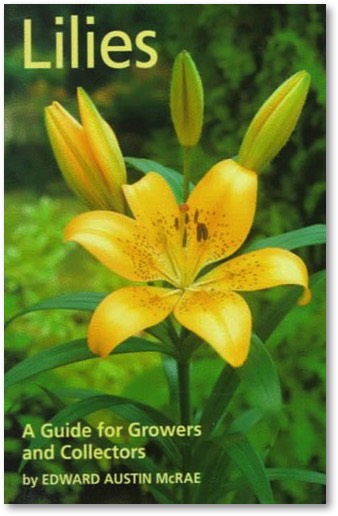
Musings » Lilies: A Guide for Growers and Collectors


Portland, Oregon
Timber Press 1998
It is very apt to consider lilies at this Easter season. Lilium candidum, the Madonna lily, has been known in the Western world for many centuries but it was depicted in ancient times by the Romans and even earlier. When it first arrived in England a wily old monk, the Venerable Bede, abbot of Jarrow in Northumberland, decided to Christianize it. Since he could not rid the populace of their devotion to this pagan flower, he pulled some theological sleight of hand and presto, it was now respectable, a symbol of the Madonna. It has never looked back. Bede is the man who wrote the first history of England
From that period to the present one in which pint sized Easter lilies show up regularly in pots at the supermarket a lot has happened. Vast amounts of empirical learning have been supplemented by advances in science, allowing breeders to reduce the size, make other changes to the plant and get it to thrive in cramped quarters. Most lilies in the wild grow extremely tall, and L. candidum is no exception.
Flowers loosely called ”lilies” appear intermittently through history. There are the flowers in the Bible, as in “consider the lilies of the field, they toil not neither do they spin”. There is no way of knowing which flowers were meant but it is highly probable it was not Lilium. The French kings’ symbol, the “Fleur de Lis” is clearly not a lily but an iris. Closer to our own gardens “lilies of the valley” are not lilies either, but belong to the genus Convallaria. While we are on this subject, what of the old proverb about not gilding the lily? The flowers are so perfect how could anyone improve them? All of this lore shows just how long the lily has been part of our civilization and culture.
True lilies are widespread throughout the Northern Hemisphere including Eastern Europe, all of Asia and all across North America. Edward McRae is a great expert and has a spent a lifetime in their study. His truly excellent book outlines the history of the plant, the best modern classification and the stories of how so many glorious varieties have become available. It has numerous handsome colored photographs.
Some lilies grow easily without special attention. Others are so fussy that even with all the care in the world they are hard to propagate. The odd thing is that this difficulty is sometimes very local indeed. A field a few hundred yards away can have utterly different results.
In the past 70 years the leading firm in the US has been the Oregon Bulb Farm started by Jan de Graaf, a native of the Netherlands and lily devotee. Even though the farm is no longer in existence De Graaf’s influence continues. A great many of today’s successful lily growers began their careers working for him, including Edward McRae. Some of our members may remember the Oregon Bulb Farm.
(Photo by Judith Freeman, in her catalogue for “The Lily Garden”)

